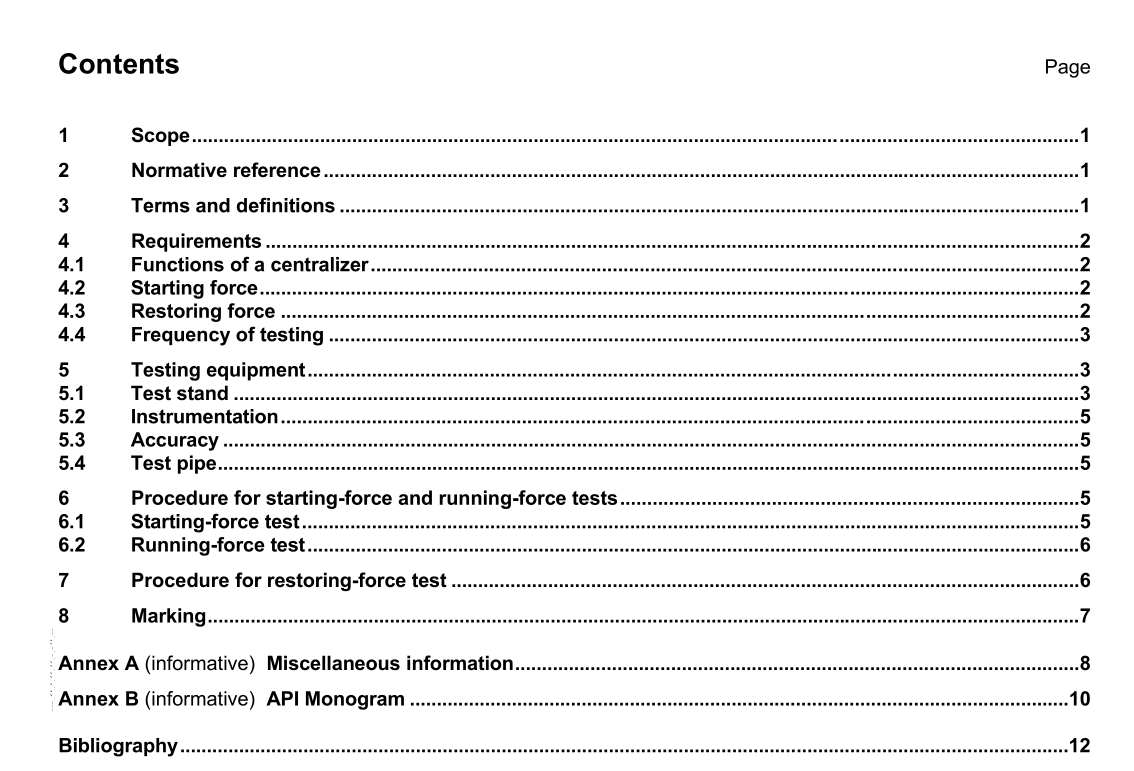API SPEC 10D pdf download

API SPEC 10D pdf download.Petroleum and natural gas industriesÊ Ñ Casing centralizers
1 Scope
This standard provides minimum performance requirements, test procedures and marking requirements for bow- spring casing centralizers for the petroleum and natural gas industries. The requirements contained herein are limited, but are deemed adequate for use in oil field cementing. The procedures provide verification testing for the manufacturerÕs design, materials and process specifications, and periodic testing to confirm the consistency of product performance. This standard is not applicable to rigid or positive centralizers.
2 Normative reference
The following normative documents contain provisions which, through reference in this text, constitute provisions of this standard. For dated references, subsequent amendments to, or revisions of, any of these publications do not apply. However, parties to agreements based on this standard are encouraged to investigate the possibility of applying the most recent editions of the normative documents indicated below. For undated references, the latest edition of the normative document referred to applies. Members of ISO and IEC maintain registers of currently valid International Standards. API Spec 5CT, Casing and Tubing ISOÊ 11960, Petroleum and natural gas industriesÊ Ñ Steel pipes for use as casing or tubing for wells
3 Terms and definitions
For the purposes of this standard, the following terms and definitions apply. 3.1 flexed condition of a bow spring when a force three times the specified minimum restoring force (±Ê 5Ê %) has been applied to it 3.2 holding device device employed to fix the stop collar or centralizer to the casing EXAMPLES Set screws, nails, mechanical dogs and epoxy resins. 3.3 holding force maximum force required to initiate slippage of a stop collar on the casing 3.4 hole size diameter of the wellbore 3.5 restoring force force exerted by a centralizer against the casing to keep it away from the wellbore wall NOTE Restoring force values can vary based on installation methods. 3.6 rigid centralizer centralizer manufactured with bows that do not flex 3.7 running force maximum force required to move a centralizer through a specified wellbore diameter NOTE Running-force values can vary depending on the installation methods. 3.8 standoff smallest distance between the outside diameter of the casing and the wellbore 3.9 standoff ratio ratio of standoff to annular clearance NOTE It is expressed as a percentage. 3.10 starting force maximum force required to insert a centralizer into a specified wellbore diameter NOTE Starting-force values can vary depending on the installation methods. 3.11 stop collar device attached to the casing to prevent movement of a casing centralizer NOTE A stop collar can be either an independent piece of equipment or integral with the centralizer.
4 Requirements
4.1 Functions of a centralizer The purpose of a casing centralizer is to facilitate running casing to the desired depth and to assist in centering the casing in the wellbore. One of the main objectives of centralizing a casing string is to facilitate a good cementing, thereby isolating fluids from different zones. A bow-spring centralizer can be constructed in various ways, using various types, shapes and quantities of bow spring. 4.2 Starting force The maximum starting force shall be less than the weight of 12,19Ê m (40Ê ft) of casing of medium linear mass as defined in TableÊ 1 . The maximum starting force shall be determined for a centralizer in new, fully assembled condition. 4.3 Restoring force The minimum restoring force for a 67Ê % standoff ratio shall not be less than the values shown in TableÊ 1. See A.2 for the derivation of the requirements.









